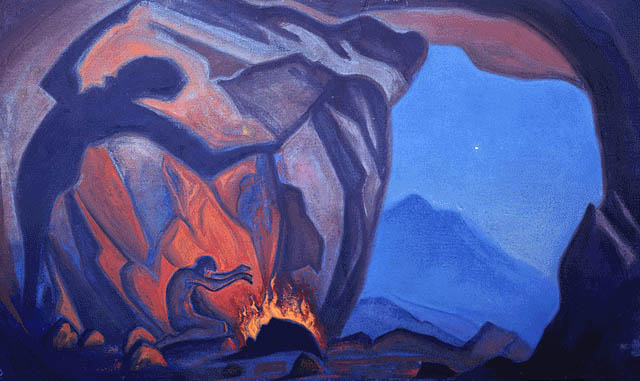On 'Noble Savage' Hermits, Shamans, and the Multifacetedness of a Symbol
29 Apr 2025

Magician, 1943, Nicholas Roerich
There is a persistent misconception in the mind of a modern man, a belief that a spiritual or religious interpretation of a given symbol is, by nature, mutually exclusive to a historical or materialist one. The origin of this assumption is almost never examined, though it probably stems from viewing the material as being locked in fundamental conflict with the spiritual. It’s either/or, rarely both.
This same sentiment manifests in other ways, in sayings like, “there are no true mystics left in the world, and if any exist, they are hiding in caves, not wasting time on the internet”, which reveals, at best, a sort of naïve idealism (and, at worst, paternalism) on the part of the speaker. What is held sacred here is not the mystic himself, but the idea, the image of what a mystic is supposed to be, a noble savage-hermit who belongs in the abode of yesterday. It is in the abode of yesterday that the mystic or shaman must remain. He is a living artifact to be studied and marveled at, but never fully engaged with as equal. Lappen ska vara Lapp; Eremiten ska vara eremit.
All of this, of course, is false dualism, born of a mind that cannot see beyond the frigid surface appearances of multiplicity.
Allow me a brief detour into a memory. Years ago, we went to visit a shaman. In Buryatia, the shamans do not withdraw from society like some mysterious forest druids; they live ordinary lives and work regular jobs. They can be doctors, teachers, police officers, businessmen, civil servants. Once suppressed and driven underground by virtually everyone, from Russian Tsarist administrators and rival Buddhist monks to the Cheka, shamanists were finally allowed to take a full breath. In the aftermath of the Soviet collapse, new shamanist organizations sprang up across Buryatia like mushrooms after the rain. Today, Buryat shamanism arguably bears many hallmarks of organized religion.
The shaman we met was a government clerk. Let’s call him Alexey. On weekdays, he worked a regular office job. On weekends, he received people for consultations at his countryside home.
We rang the bell, and moments later, a middle-aged Buryat man emerged from behind the gate. The inside of his house was just what you would expect from a rural countryside home: modest but tidy, with aged wooden floors, pale blue walls, floral-patterned blankets, and a clay stove. The only things that hinted at anything unusual were a drum, a headdress, and ongon figurines on the wall.
I’ll leave out the details of our conversation, as they’re probably better suited to a different context. But at no point during the session did he reach for the shamanic garb or accessories, as an outsider might expect. Some shamans do it for show; then again, most of those are charlatans. I don’t think Alexey was one of them.
Before we left, my sister-in-law asked, “So, why did you become a shaman?”
Alexey chuckled and said, “It’s not like we have a choice in this, do we?”
What he meant was that spirits do not simply vanish because humans dismiss them as relics of the past. In Buryat, and more broadly, Siberian shamanism, there is a phenomenon known as “shamanic illness.” A man or woman, typically in their 40s (though sometimes younger), undergoes a sudden onset of illness or a life crisis. They may fall sick, lose family members, experience madness, visions or hallucinations, suffer from strange dreams, or fall into depression. This can last for months and even years, until they are invited, in a dream, to accept the calling of a shaman and undergo initiation. If they accept, the initiation ceremony begins; if they refuse, the spirits take their revenge. Revenge takes many forms, but more often than not, it culminates in the death of the person or that of a close family member.
I’m reminded of this story because shamans and monks were not seen as something exotic or separate from the rest of society, or from our reality. They inhabited the same world as everyone else, and yet, in some way, they also transcended it. My family and I lived an otherwise ordinary life, no different from that of people elsewhere in Russia. In hindsight, however, it was growing up in Buryatia that showed me how the ‘exoteric’ and ‘esoteric’ can coexist within a collective and, on a more microcosmic level, within an individual.
But, coming back to the symbols — a symbol, by its nature, contains a multitude of meanings, of low and high orders, literal and abstract. The correct way to look at it is as a superimposition of layers. An exoteric interpretation of a symbol does not automatically invalidate the esoteric one, and vice versa. Symbolism is inherent to nature, and nature itself amounts to no more than a symbol of the transcendent realities, echoing the verses of the Quran: “We will show them Our signs in the horizons and within themselves until it becomes clear to them that it is the truth”(41:53) and “Indeed, in the creation of the heavens and the earth and the alternation of the night and the day are signs for those of understanding.” (3:190-191)
A symbol can operate on a purely intellectual level, a moral or psychological level, and a metaphysical or divine level. Guénon in The Symbolism of the Cross presents perhaps the most thorough exploration of this idea, examining the Cross as the universal symbol that can be interpreted on multiple levels of abstraction. I will be publishing my notes on this subject incrementally in the follow-up posts, and may revise this blog entry later; but for now, let it stay as is.